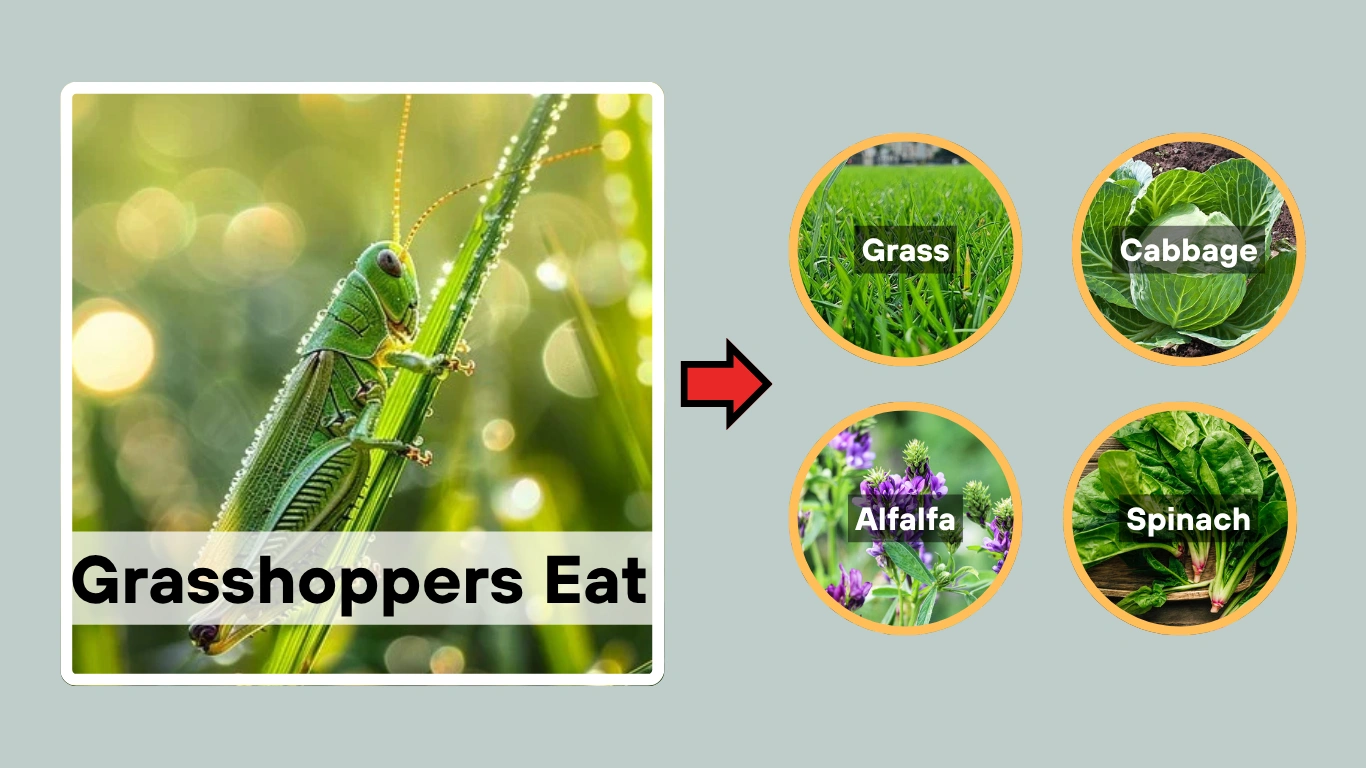Grasshoppers are known for their impressive appetite and their love for greenery. Whether they’re hopping through a field or nibbling on your garden plants, these insects have a surprisingly wide diet. While most people assume grasshoppers only eat grass, they actually enjoy a variety of plants, vegetables, and even some unexpected items. In this article, we’ll explore 15 things grasshoppers like to eat, from crops to weeds—and even what they might snack on in captivity. Whether you’re curious or trying to protect your garden, you’ll find everything you need here.
Understanding the Grasshopper Diet

Grasshoppers are primarily herbivores, meaning they feed mostly on plant-based materials. Their diet plays a crucial role in both their development and the ecosystems they live in. Whether in a wild field or your backyard garden, understanding what they eat helps explain why they can sometimes become agricultural pests.
Herbivorous Nature
Grasshoppers rely on strong chewing mouthparts to consume plant matter. Their primary food sources include grasses, leafy greens, and crops. They are attracted to soft, green vegetation but are capable of chewing through tougher plant parts as well. This chewing ability makes them effective feeders, capable of consuming large amounts of food relative to their size.
Occasional Omnivorous Behavior
While rare, grasshoppers may show omnivorous tendencies when food is limited. In dry or barren conditions, they’ve been observed nibbling on dead insects, animal feces, or decaying organic matter. However, this is not a regular part of their diet and usually occurs only in extreme survival situations.
15 Things Grasshoppers Like to Eat

Grasshoppers may seem simple, but their food choices are surprisingly diverse. Below are 15 specific things grasshoppers enjoy eating, whether in the wild or in gardens and fields. This variety explains why they can become a problem for farmers and gardeners alike.
1. Grass
Grass is the most common and natural food source for grasshoppers. They feed on various types of grasses found in meadows, lawns, and farmlands. Their strong mandibles allow them to chew through blades easily, making grass an essential part of their daily intake.
2. Leaves
Grasshoppers often feed on soft, green leaves from shrubs, herbs, and garden plants. They prefer younger leaves that are easier to chew and digest. Their leaf consumption can lead to noticeable damage in gardens and wild plant populations.
3. Corn
Corn is a favorite crop for many grasshopper species. They consume the leaves, stalks, and even the husks of developing corn ears. Large infestations can lead to significant agricultural loss in cornfields.
4. Wheat
Wheat plants attract grasshoppers, especially during their growing season. These insects chew on the stems and leaves, sometimes damaging entire wheat patches if the infestation grows.
5. Oats
Oats are another cereal crop frequently eaten by grasshoppers. They feed on the leaves and can reduce crop yields, especially in dry conditions when other food sources are scarce.
6. Alfalfa
Alfalfa is a protein-rich plant that grasshoppers enjoy, especially when it’s young and tender. Farmers often struggle with grasshoppers during alfalfa’s early growing phases, as it’s highly palatable.
7. Lettuce
Lettuce leaves are soft and water-rich, making them a preferred garden snack. Grasshoppers can chew through entire heads of lettuce quickly, leaving behind ragged and damaged leaves.
8. Carrot Tops
While they don’t eat the roots, grasshoppers love the leafy green tops of carrots. These greens are tender and nutrient-rich, attracting grasshoppers in garden settings.
9. Cabbage
Cabbage leaves, especially when forming heads, are vulnerable to grasshopper feeding. The thick leaves provide nutrition and water, especially important during dry seasons.
10. Clover
Clover is common in pastures and meadows, making it an easy and favored food. Grasshoppers feed on its soft leaves and flowers, which are rich in moisture.
11. Dandelions
These wildflowers are not only resilient but also edible to grasshoppers. The leaves and flowers are soft, making them ideal for these insects to chew and digest.
12. Soybeans
Soybean fields are attractive to grasshoppers due to the plant’s lush foliage. Grasshoppers target the leaves and can harm the overall health and yield of the crop.
13. Bark and Stems (Young Shoots)
When leaves are not available, grasshoppers may resort to chewing on young stems or soft bark. While not preferred, it provides a backup food source during food shortages.
14. Weeds (Like Pigweed and Lambsquarters)
Common weeds often serve as abundant food sources. Grasshoppers are not picky and will eat many weedy plants that grow wild in fields and along fences.
15. Decaying Organic Matter (Rare Cases)
In survival situations, some grasshoppers may consume decaying leaves, compost, or even rotting fruit. This helps them stay alive when fresh vegetation is not available, although it’s not their first choice.
What Do Baby Grasshoppers Eat?
Baby grasshoppers, known as nymphs, have a diet very similar to adults. From the moment they hatch, they begin feeding on tender vegetation. However, because they are smaller and still developing, they prefer soft, easy-to-digest plant material like young leaves, grass blades, and seedlings. These foods provide the essential nutrients for their rapid growth during the early stages. As they molt and grow, their appetite increases significantly, and they begin to eat tougher leaves and stems, just like adult grasshoppers.
What Grasshoppers Eat in Captivity

Grasshoppers raised in captivity need a diet that mimics their natural feeding habits. Owners often provide leafy greens such as lettuce, cabbage, dandelion greens, and spinach. Some may also offer soft vegetables like carrot tops, zucchini slices, or herbs like parsley and cilantro. Freshness is key—wilted or chemically treated produce should be avoided. A small container with a damp sponge or leaf can be added to supply moisture since grasshoppers don’t drink from open water like other pets.
What They Should Avoid Eating
Despite their strong chewing mouthparts, not all plants are safe for grasshoppers. Certain toxic plants like nightshade, milkweed, hemlock, and foxglove can be harmful or even fatal to them. Also, grasshoppers should avoid crops or vegetation treated with pesticides, herbicides, or chemical fertilizers. Even in small amounts, these substances can disrupt their digestion and lead to death. If you’re caring for grasshoppers or managing their presence around crops, it’s important to identify and limit exposure to harmful plants and treated areas.
Grasshopper Feeding Behavior

Grasshoppers are most active during the daytime and often feed in the early morning or late afternoon when temperatures are moderate. Their strong mandibles allow them to chew steadily through tough plant fibers, and they often feed directly on the outer edges of leaves, leaving behind distinct bite marks. They don’t store food; instead, they graze frequently throughout the day. In high populations, their feeding can become synchronized, leading to widespread destruction of crops and vegetation in a very short time.
Feeding Times and Quantity
Grasshoppers can consume up to 50% of their body weight in plant matter each day. Younger nymphs eat more frequently as they grow through molts. In areas with plenty of vegetation, they spread out and feed gradually. But in dry conditions, they may swarm and compete for limited food, leading to more aggressive feeding behavior. This is especially true in species that form locust-like groups under environmental stress.
Why Knowing Their Diet Matters
Understanding what grasshoppers eat is important for both gardeners and insect enthusiasts. Their feeding habits impact agriculture, natural vegetation, and even pest control strategies. Knowing their dietary preferences helps manage their presence in a more informed and sustainable way.
For Gardeners and Farmers
Grasshoppers can quickly ruin garden beds and crops. Recognizing their favorite foods—like lettuce, cabbage, or alfalfa—can help in monitoring and preventing infestations. Farmers may use natural deterrents or companion planting to make crops less attractive to these insects.
For Pet Owners and Enthusiasts
Grasshoppers are sometimes kept as feeder insects or studied for educational purposes. Providing a natural, healthy diet in captivity ensures their well-being and helps them live longer. It also prevents them from chewing on unsuitable or toxic materials in enclosed environments.
FAQs About Grasshopper Diet
1. Can grasshoppers eat fruit?
Grasshoppers usually avoid fruit, but they may nibble on soft, overripe ones like peaches, apples, or berries if plant greens are unavailable. However, it’s not their preferred food.
2. Do grasshoppers eat flowers?
Yes, some species feed on flowers such as dandelions, daisies, or marigolds. They may chew through petals and soft centers, especially in gardens.
3. Will grasshoppers eat other insects?
Grasshoppers are not naturally carnivorous, but in extreme hunger, some may consume dead insects. This behavior is rare and not part of their normal diet.
4. What do grasshoppers drink?
Grasshoppers don’t drink water like many animals. Instead, they get most of their moisture from the plants they eat, especially soft leaves and shoots.
5. Are grasshoppers harmful to crops?
Yes, in large numbers, grasshoppers can destroy entire fields. They are known to eat a wide variety of crops, leading to significant agricultural damage if left uncontrolled.


